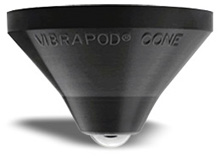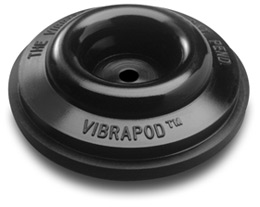 |
| March 1, 2005 Vibrapod Isolators and Cones It’s a sedentary life . . .
And lest you judge as overweening the plural of Kennard Industries, I Googled and discovered that Kennard maintains other than an audiophile presence. A huge range of flexible pipe grommets resembling the Vibrapod Isolator may very well have been the device’s inspiration. There’s also an HVAC connection. The Vibrapod website leaves one feature in the dark. We learn that the solid-vinyl Vibrapod Cone, which can be used by itself or with a cushiony Vibrapod Isolator, is available in an assortment of apices besides the standard tungsten-carbide ball bearing: ceramic, plastic, glass, titanium, and wood. In response to my e-mail, Kennard acknowledged that his website does not provide information about these alternative terminations, but said that the tungsten-carbide ball works best. So why the mystery options? Anyway, we do learn that a 7/16" ball can replace the routinely supplied 3/8" ball for an increase in weight-bearing capability. (A late-arriving e-mail stated that Vibrapod Cones, as supplied, will from now on be fitted exclusively with 7/16" balls, raising their weight-bearing capability from ten pounds per cone to 25 pounds. These should be available by the time this report appears.)
A card accompanies each clear-plastic-enclosed foursome of Vibrapod Isolators; it unfolds to reveal text and illustrations that tell you just about everything you need to know with respect to placement. Most impressive. . . . but it has its attractions . . . The Mark Levinson No.390S CD player sits atop my isolation reference, a component-specific SRA Ohio Class platform, on a low Chinese cabinet. My first test CD comes from a two-disc set of Beethoven’s string quartets, Vol.4 of four, performed by the Auryn Quartet [Tacet 130]. These excellent productions are consistent throughout the quartets in that they tend to sound bright rather than mellow. With player directly on cabinet, the discs don’t sound particularly inviting. My second test CD comes from another two-disc set, Anthony Braxton’s Charlie Parker Project, 1993 [hatOLOGY 2-612]. The string quartet recordings are particularly apt at revealing differences in texture, precise location, and air. As mentioned, without benefit of any acoustic isolation, I would not commend them for the sonic qualities that become apparent with the CD player on its SRA platform. That mischief is best described as a diminution of resolution and transparency, thus diminutions in microdynamics, air, timbral textures, and soundstage definition. In additive terms, there is grain; subjectively, it irritates. When resolution diminishes, everything an audiophile cherishes suffers. The Braxton discs, with their biting reeds, winds, and percussion, and their solid bass line, serve as an excellent complement to the string quartets at revealing descents into harshness. . . . and I do have a gavel . . . I could not evaluate a tripod arrangement of footers, which Kennard’s website offers as a placement variation -- a midway trench along the ML player’s bottom necessitates four. Also, in positioning Cones, alone or in combination with Isolators, I was obliged to place them close to the player’s own feet rather than directly under. Cavities at the center of the player’s feet prevent the Cones from making solid contact with the player’s body. I began with Vibrapod Isolators alone, first with their ring aspect upward, then ring aspect down. I also tried them directly under the player’s own feet, and later nearby, where (as mentioned) I later used them in combination with Vibrapod Cones. Finally, I used Models 2 and 3 in combination, a pair of 3s under the player’s heavier side, and then returned to all 3s. None of these variations asserted much influence on my initial impression. The Vibrapod Isolator foursome did a reasonably effective job of smoothing over the harshness I’d heard with the player in direct contact with the cabinet. It wasn’t Nirvana. I missed the exquisite focus and refinement the SRA platform brought to the mix. This is, of course, an unfair comparison. Given their low prices, the Vibrapod Isolators are effective bargains. The verdict: a bipartite winner! The Vibrapod Cones alone did about as well at smoothing over harshness, and with respect to focus, they surpassed the Vibrapod Isolators. However, I’m saving my last (and detailed) hoorah for Vibrapod Isolators and Vibrapod Cones in combination. Together, cones atop Isolators, they achieved a beautiful synergy -- and looked nifty, too. I again heard that sense of air and soundstage verisimilitude that serve as the hallmarks of a high-resolution sound system. So, a match for the SRA platform? Not quite -- but while I still missed those ultimate touches of dynamic finesse, top-end extension, midrange presence, low-end solidity, and precise localization, the differences were not so gross as this sentence might suggest. Indeed, four Isolator-Cone combos offered my ne plus ultra SRA reference a not inconsiderable challenge. Best of all, Vibrapod Isolators and Vibrapod Cones are inexpensive enough to experiment with. And Kennard offers a 30-day return policy, along with as much information as you could possibly put to use. How can you lose? …Mike Silverton Price: Vibrapod Isolators, $24 USD/set of four; Vibrapod Cones, $8 USD/each. Warranty: Lifetime. The Vibrapod Company E-mail: sales@vibrapod.com
Ultra Audio is part of the SoundStage! Network. |
 Enthusiasts! We who are
about to review salute you! Actually, folks, just me, Mike, back again with another
acoustic-isolation report. Today it’s Kennard Industries’ Vibrapod Isolators and
Vibrapod Cones. By all means read my deathless prose through to the very end, but
don’t neglect to visit
Enthusiasts! We who are
about to review salute you! Actually, folks, just me, Mike, back again with another
acoustic-isolation report. Today it’s Kennard Industries’ Vibrapod Isolators and
Vibrapod Cones. By all means read my deathless prose through to the very end, but
don’t neglect to visit  A Vibrapod Isolator looks
like a sealed, ring-shaped cushion. In fact it’s a molded form, the ring aspect open
at the bottom. Vibrapod Isolators come four to a package in five weight-bearing
categories, from the Model 1 (2-3 pounds per pod) to Model 5 (22-28 pounds). As with
GutWire’s NotePads, I evaluated the Vibrapod Isolators and Cones with my Mark
Levinson No.390S CD player, nothing else (line conditioning, etc.) altered or removed. I
used the Models 2 and 3, rated respectively at 4-8 and 8-12 pounds per pod, by themselves
and in combination -- 2s here, 3s there -- to account for the player’s uneven weight
distribution. I also used Vibrapod Isolators in combination with Vibrapod Cones.
A Vibrapod Isolator looks
like a sealed, ring-shaped cushion. In fact it’s a molded form, the ring aspect open
at the bottom. Vibrapod Isolators come four to a package in five weight-bearing
categories, from the Model 1 (2-3 pounds per pod) to Model 5 (22-28 pounds). As with
GutWire’s NotePads, I evaluated the Vibrapod Isolators and Cones with my Mark
Levinson No.390S CD player, nothing else (line conditioning, etc.) altered or removed. I
used the Models 2 and 3, rated respectively at 4-8 and 8-12 pounds per pod, by themselves
and in combination -- 2s here, 3s there -- to account for the player’s uneven weight
distribution. I also used Vibrapod Isolators in combination with Vibrapod Cones.